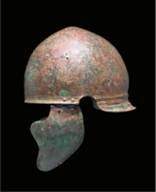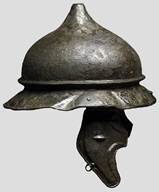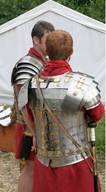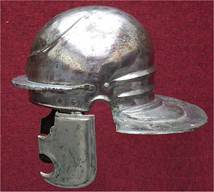

Roman Empire
Although there is no evidence to support this claim, legends have it that Rome was founded in 753 B.C. by Romulus. Rome was under Etruscan rule for 2 centuries before it became a republic. Rome expanded into a vast empire from a mixture of subjugation and politics until its fall in 410 A.D. Although part of the empire continued after that date it changed dramatically and became a new empire entirely which came to be known as the Byzantine Empire. The Roman civilization is one of the most widely studied civilizations and tremendous amounts of information exist concerning it in the form of books and websites.
The most prominent metals of used in this period are gold, silver, bronze, enameling, and iron. The Romans utilized the process of smelting with charcoal in a fire or furnace to process ores into useable metals. The smelting process was used to turn metals into ingots that were transported into manufacturing centers all over the empire to produce artifacts, coins, arms, and armors. Iron was the most prominent metal of this time and found most of its use in tools, fittings, and weapons. Armors were also made with iron, but there was still some that were manufactured in bronze.
HELMETS |
|
 |
Name: Montefortino helmet. Origin: 4th century BC-1st century AD. Excavated in the town of Montefortino in Ancona, Italy. The Montefortino helmet can be described as the calotte or Negau helmet with added check pieces on its sides, an outward extended back to be used as a neck guard, and a topknot. It is estimated that about 3 to 4 million of this type of helmet was produce, making it one of the first mass production product of the ancient world. |
 |
Name: Port Type helmet. Origin: 1st century BC. Named after Port-bei Nidau, Switzerland. The Port Type helmet was developed from Montefortino helmets that lacked the topknot which were labeled as Coolus helmets. The helmet was formed by forging in one piece in the shape of a hat with a conical point, reinforced with riveted sheet-iron protection over the forehead with oval cut-outs arched like eyebrows. |
|
Name: Imperial-Gallic/Weisenau helmet. Origin: 1st-5th century AD. This helmet possessed an enlarged neck guard and was reinforced by adding a strip across the front of the helmet to protect the face from slashes. It also possessed “stylized eyebrows” on the helmet bowl, which distinguished it from the Imperial-Italic helmets. |
|
CUIRASS |
|
 |
Name: Scale armor. Origin: 1st and 2nd century AD. It is said to have been invented somewhere in the east and was very popular in the Assyrian civilization. The scale armor is composed of rows of overlapping bronze and/or iron scales 10-50 mm long made to look very similar to fish scales. These scales were sewn into a fabric garment underneath with an extra layer of straw to be added in between the scale and the garment for extra strengthening. |
 |
Name: Laminar armor/ Lorica Segmentata. Origin: 1st century BC- 2nd century AD. Roman civilization. The Lorica Segmentata is a purely Roman invention. It weighed about 9 kg and was made of metal plates held together by leather straps and buckles or by hooks. The hooks and straps fastening of the armor was not strong enough to withstand dramatic movements by its wearer and would thus wear down and break. |


Integrative Materials Design Center - Worcester Polytechnic Institute
